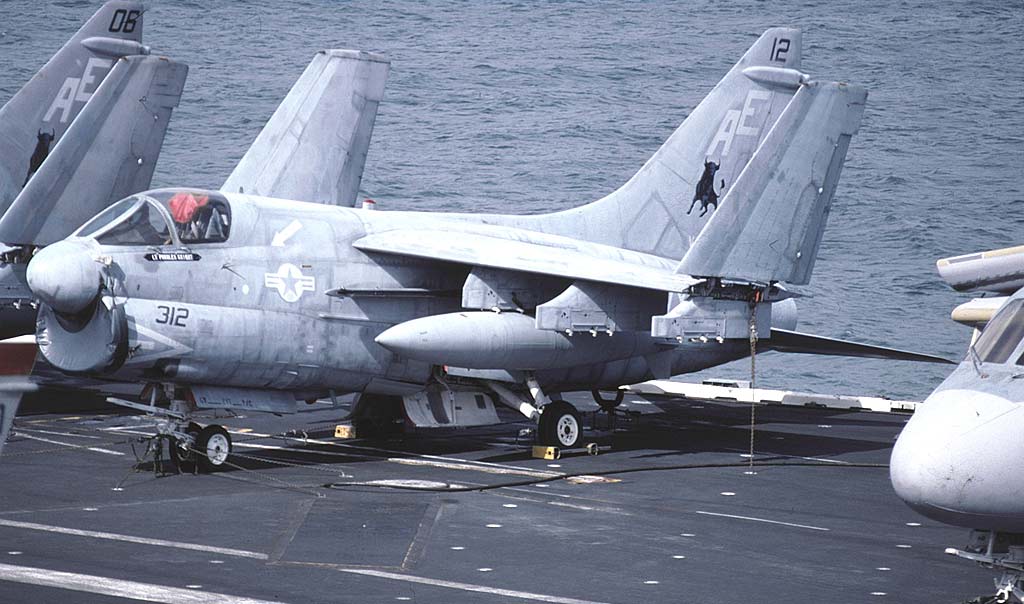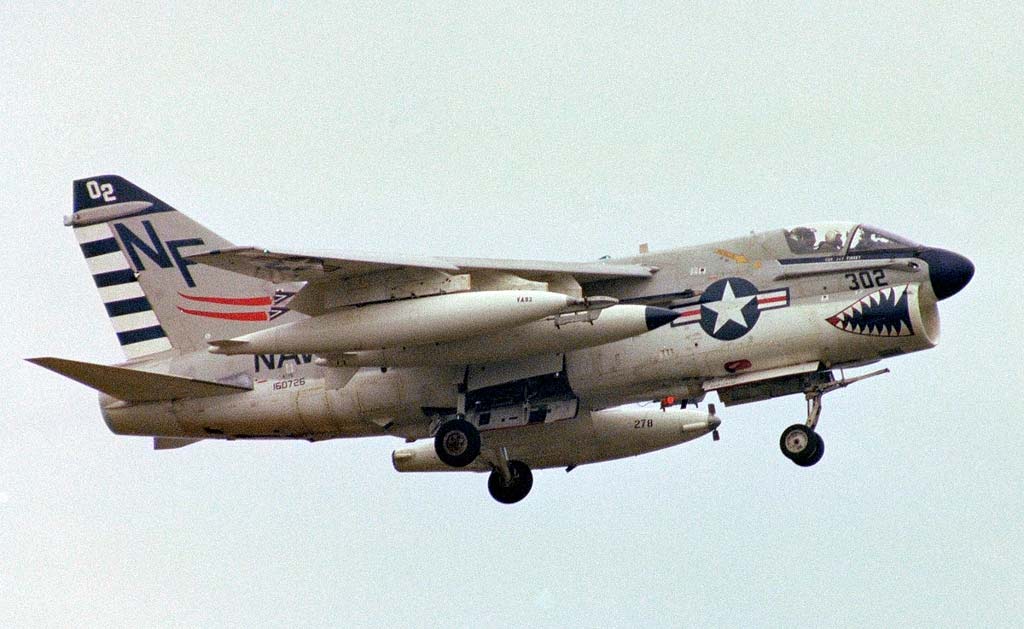The LTV A-7 Corsair II, a carrier-capable subsonic light attack aircraft, is renowned for its high payload, precision strike capability, and cost-effectiveness.
In Brief
The LTV A-7 Corsair II, developed by Ling-Temco-Vought, is a subsonic, carrier-based light attack aircraft introduced in the 1960s. It was designed to replace the Douglas A-4 Skyhawk, offering greater payload, advanced avionics, longer range, and better endurance. Powered by a single Allison TF41-A-1 turbofan engine, the A-7 was capable of carrying a wide array of ordnance over considerable distances with its sophisticated navigation and weapon delivery system. The aircraft featured a head-up display (HUD) for improved attack accuracy, an inertial navigation system, and was one of the first to have an integrated digital weapon delivery system, paving the way for modern precision strike aircraft.
The LTV A-7 Corsair II stands out as a significant evolution in naval aviation, bridging the gap between early light attack aircraft and the sophisticated multi-role fighters that followed.

History of the Development of the LTV A-7 Corsair II
In the early 1960s, the U.S. Navy sought a replacement for the A-4 Skyhawk that could carry a heavier payload and had a greater range to enhance its strike capabilities. The Ling-Temco-Vought (LTV) company responded with the A-7 Corsair II, which first flew on September 26, 1965. The design borrowed heavily from the F-8 Crusader, particularly in the wing and tail designs, but introduced more advanced avionics and systems, setting a new standard for light attack aircraft.
The development aimed to produce an aircraft that was not only capable of delivering weapons with high accuracy but also versatile enough to perform in a variety of missions, including close air support, tactical bombing, and naval interdiction. This period marked a significant transition in military aviation, moving towards integrating sophisticated electronics to enhance aircraft capabilities.
Design of the LTV A-7 Corsair II
The A-7 Corsair II was designed with a focus on reliability, ease of maintenance, and cost-effectiveness. Its airframe was robust yet simplistic, enabling operations from both land bases and aircraft carriers. The aircraft employed a single Allison TF41-A-1 turbofan engine, providing a balance between performance and fuel efficiency, crucial for the aircraft’s long-range strike missions.
The A-7’s avionics were revolutionary, featuring one of the first heads-up displays (HUD) along with a sophisticated navigation and attack system, which significantly improved bombing accuracy and pilot situational awareness. Its design allowed for an impressive payload capacity, enabling it to carry a variety of weapons, including guided missiles, gravity bombs, and even tactical nuclear weapons, making it one of the most versatile light attack aircraft of its time.
Performance of the LTV A-7 Corsair II
The A-7 Corsair II demonstrated excellent performance as a carrier-based light attack aircraft. With a top speed of over 600 mph and a range of approximately 2,000 nautical miles with external fuel tanks, it was well-suited for a variety of mission profiles. Its ability to carry up to 15,000 pounds of mixed ordnance over long distances was unmatched at the time, providing the U.S. Navy and Air Force with a significant tactical advantage.
The aircraft’s subsonic speed was considered a limitation compared to supersonic fighters; however, its sophisticated avionics, reliability, and payload capacity made it an invaluable asset, proving that high-speed was not the sole determinant of an aircraft’s effectiveness in combat.
Variants of the LTV A-7 Corsair II
Several variants of the A-7 were developed to suit different operational requirements:
- A-7A/B/C: Initial versions for the U.S. Navy with varying improvements in avionics and engines.
- A-7D/E: U.S. Air Force and Navy variants with upgraded engines and avionics, enhancing their strike capabilities.
- A-7H/J: Export versions for Greece and Thailand, respectively, with specific modifications to meet their operational needs.
Each variant incorporated enhancements to improve performance, payload capacity, and mission flexibility.

Military Use and Combat of the LTV A-7 Corsair II
The A-7 saw extensive combat service, particularly during the Vietnam War, where it was used for close air support, interdiction, and strike missions. Its precision in weapon delivery, coupled with its endurance, made it an effective platform for sustained combat operations. The aircraft participated in numerous subsequent conflicts, including the Gulf War, where its capabilities as a night and all-weather attack aircraft were utilized to their full extent.
Despite facing more modern aircraft, the A-7 proved its worth by delivering ordnance accurately and surviving in high-threat environments, a testament to its robust design and the effectiveness of its avionics in combat scenarios.
The LTV A-7 Corsair II significantly impacted modern air warfare with its advanced avionics, impressive payload capacity, and operational versatility. It set new standards for future generations of attack aircraft, blending cost-effectiveness with sophisticated weapon delivery systems. Even as newer technologies emerged, the enduring legacy of the A-7 Corsair II remained evident in its contributions to tactical air power and its role in shaping modern air combat strategies.
Back to the Fighter Jet section.